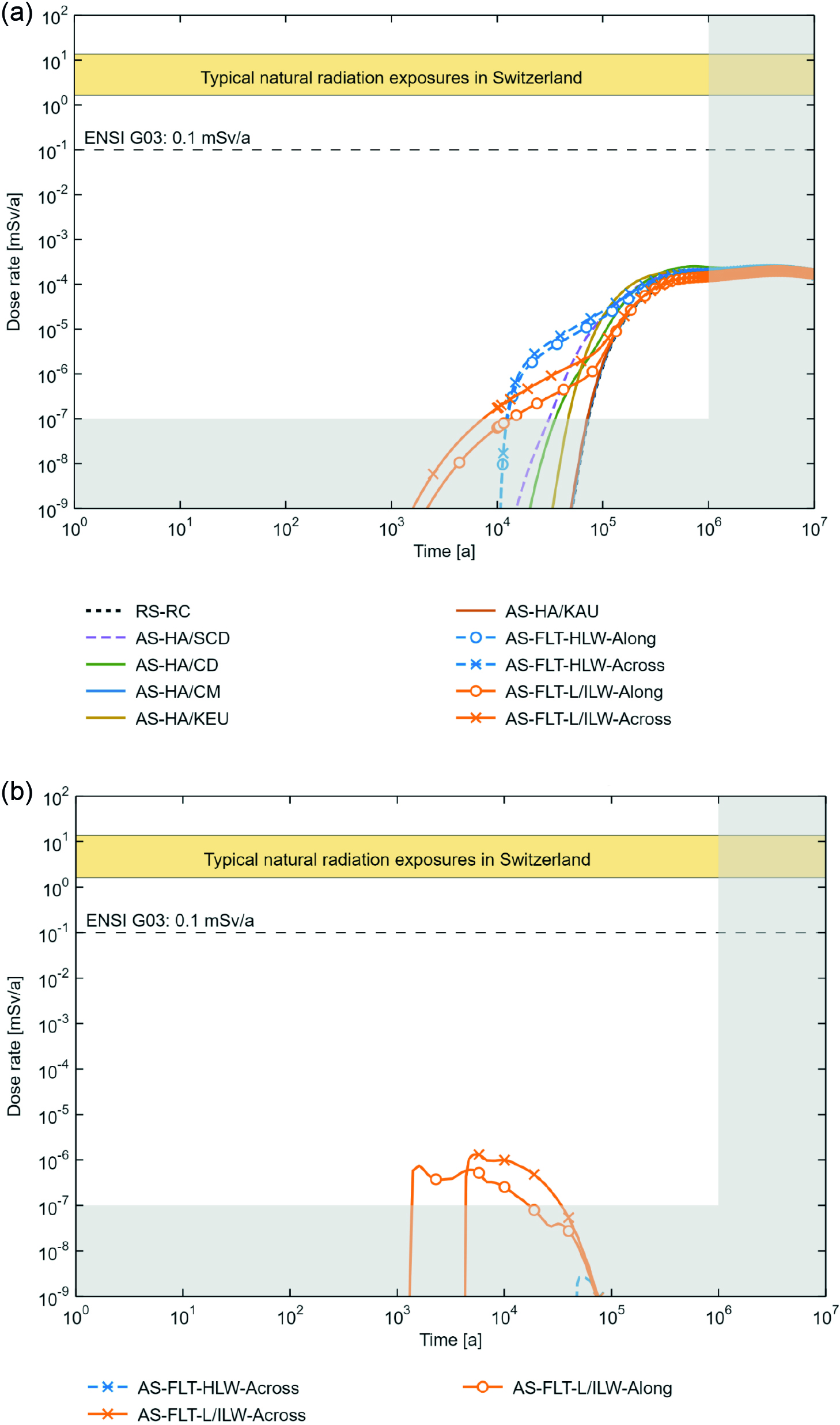As described in Section 7.3, two alternative safety scenarios that address uncertainties in geological characterisation have been identified:
-
one of the confining geological units above (variant one) or below the Opalinus Clay (variant two) provides a horizontally connected advective pathway connected to the regional aquifer, and thus provides an additional pathway for advective transport of radionuclides,
-
an undetected fault, with a transmissivity that is in the range of what could reasonably be expected in such a scenario, exists in the vicinity of the repository at the time of its construction. The undetected fault could intersect either the HLW or the L/ILW repository section, leading also to two variants for this alternative safety scenario.
Finally, sets of calculation cases are considered for the two alternative safety scenarios as summarised in Tab. 8‑2 and Tab. 8‑3 (for details and illustrations see Section 7.3). Tab. 8‑2 also indicates which radionuclide transport pathways are considered for which calculation case for the first alternative scenario. In fact, since gas-phase-mediated transport is directed upwards, the two-phase flow computation accounting for 14C as methane is used -conservatively- for the closest hydraulically active unit above the repository.
Tab. 8‑2:Calculation cases for the alternative safety scenario that assumes an additional hydraulically active unit within the CRZ above or below the Opalinus Clay
The transport modelling approach refers to the two modelling approaches: one that assumes all radionuclides dissolve and migrate through the repository barrier system in the aqueous phase, and one in which gaseous 14C migrates, along with other repository-generated gas, in a two-phase flow regime. Only case AS-HA/SCD is modelled by the latter approach, since this is the most conservative case.
|
Variant |
Case |
Transport modelling approach |
Description |
|
| Aqueous phase | Two-phase | |||
|
Additional hydraulically active unit within the CRZ above the Opalinus Clay |
AS-HA/SCD |
✓ |
✓ |
Hydraulically active “SCD” unit (Sandy-Calcareous Dogger) |
|
AS-HA/CD |
✓ |
× |
Hydraulically active “CD” unit (Calcareous Dogger) |
|
|
AS-HA/CM |
✓ |
× |
Hydraulically active “CM” unit (Calcareous Malm) |
|
|
Additional hydraulically active unit within the CRZ below the Opalinus Clay |
AS-HA/KEU |
✓ |
× |
Hydraulically active “KEU” unit (Calcareous Lias/Argillaceous Keuper) |
|
AS-HA/KAU |
✓ |
× |
Hydraulically active “KAU” unit (Dolomitic and Argillaceous Keuper) |
|
Tab. 8‑3:Calculation cases for the alternative safety scenario that assumes an undetected fault.
All cases are calculated using both modelling approaches: aqueous-phase transport and two-phase transport of 14C.
|
Variant |
Case |
Description |
|
Fault intersects the HLW emplacement drifts |
AS-FLT-HLW-Along |
Fault strike runs along the axis of a single emplacement drift |
|
AS-FLT-HLW-Across |
Fault strike runs perpendicular to drifts, cutting each drift at its centre |
|
|
Fault intersects the L/ILW emplacement caverns |
AS-FLT-L/ILW-Along |
Fault strike runs along the axis of a single emplacement cavern |
|
AS-FLT-L/ILW-Across |
Fault strike runs perpendicular to caverns, cutting each cavern at its centre |
The results in the form of dose rates are shown for all the calculation cases of the alternative safety scenarios in Fig. 8‑8 for both (a) the aqueous phase and (b) two-phase transport. For the aqueous phase results, the reference case is also shown for comparison (for two-phase transport, the dose rate for the reference case is negligible). It can be easily noted that the presence of hydraulically active units has a limited effect on the results. Dose rates can increase minimally, and appear only slightly earlier compared with the reference case.
In contrast, the presence of an undetected fault could lead to releases to the biosphere at significantly earlier times, especially in the cases when the fault intersects the L/ILW emplacement caverns. An undetected fault also leads to a noticeable – albeit still very low – dose rate contribution of 14C as methane that migrates via a gas phase. However, for this alternative safety scenario, the overall dose rate maxima are again only marginally affected.
In general, similarly comfortable safety margins remain when compared with the reference safety scenario.

Fig. 8‑8:Dose curves for the calculation cases of the alternative safety scenarios and radionuclide transport in (a) the aqueous phase and (b) for the two-phase transport of 14C (only 3 cases lead to dose rates higher than 10-9 mSv/a)

